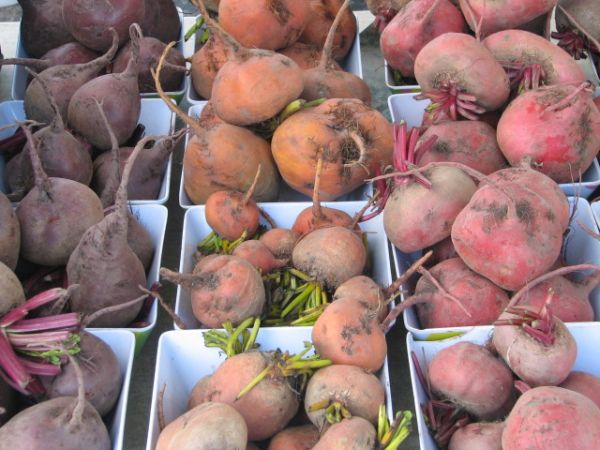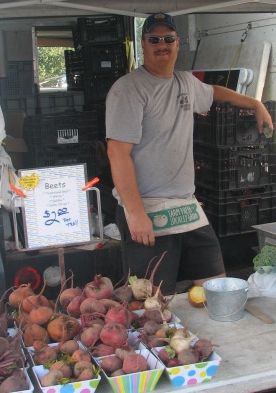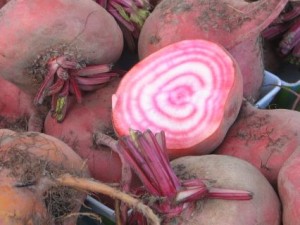
Don Heinel’s family has been raising beets for as long as he can remember — longer, in fact. “There is a story my grandparents used to tell,” he says. “During World War II, the government was looking for an area to grow beets for the soldiers. Our area had the right soil and nutrients to grow the beets, but we couldn’t participate because we didn’t have a truck that could go the distance, that could get the beets to Wisconsin.”
For his grandparents, this was not a story of regret, of the dime that got away: “No, it was more about pride: The soil here grows the best beets.”
“Here” is Little Canada, MN, where Heinel’s family has farmed 17 acres since 1912, growing everything from parsnips to cauliflower (“Four kinds, including white, orange, purple, and green romanesco – it’s fractile!” he says) and winter squash to sweet corn, tomatoes, and fennel. Each season, he grows around three acres of beets. “I do raise quite a few, but an exact number is difficult because I tend think in rows, not individual vegetables, so it’s hard to get a good guestimate of what I plant.”
Heinel can only speculate why Uncle Sam wanted to feed the troops beets in particular — it’s likely they were looking for nutritional, cheap, and easy-to-grow foods that could be canned, shipped, and dispersed — but he does have some thoughts about why his land grows good beets. “Beets have a high concentration of sugar, depending on the soil they are raised on,” he says. “They need a stable level of nutrition; good water and heavier soil will grow a better tasting beet.”
A lighter soil has a sandy loam, which drains well and can be great for growing vegetables, but beets prefer a black to chocolate loam with a clay bottom to retain water. “It’s not something you create — it’s formed through glacial movement,” Heinel says. “Well, you might be able to create a loamy soil, but there’s something about it being that way to begin with… certain regions just grow things better than others.”

According to Heinel’s father, scientists from the University of Minnesota tested the soil in Little Canada and likened its composition to that of soil in the Red River Valley, which was formed by a glacial lake. “Glaciers deposited things in certain ways,” he says, “and I’m assuming that’s how the soil was created. I don’t add things, I’m not hauling in dirt or soil, so I’m also assuming it has been this way for a long time.”
He may be bit loose on his glacial theory, but the sweetness of his beets has been scientifically tested. Last year, a fellow farmer used a Brix Refractometer, an instrument that uses light refracted through a drop of juice to measure sweetness, to test the sugar in Heinel’s beets. “Testing was something I intended to do to help sell the beets. The Brix test gives it a number: The higher the number, the higher the level of sucrose, the better the product.”
Heinel doesn’t recall the exact number, but he says it was somewhere between good and excellent.
What would he have done if the sucrose was low? “If I saw in inconsistency in how the beets cooked or if they tasted woody, I would have to make an amendment to the soil,” he says. “That would probably mean sending out a soil sample for testing, finding out what’s missing, and then planting cover crop that would help me put it back. I’d probably use rye or red clover.”
Red clover has nodules on its roots that deposit nitrogen in the soil; rye adds humus, or decomposed organic matter, to the soil and chokes out the weeds in the fall and winter. “That’s how the soil has been built up for so long; I’d rather do that then apply a chemical. And to be honest, because we do that, I’d be shocked to find a lack of nutrients.”
Heinel grows four kinds of beets: red, golden, white, and candy stripe. He says all of the beets have pretty much the same amount of sugar, except the white, which has a bit more. So why do golden and candy-stripe beets taste so much sweeter? “They lack the intensity of flavor, that strong earthy, slightly bitter flavor that the red and white beets have,” he says, “so you can taste the sugar more.”
Heinel’s beets are available at the Shoreview Farmers Market on Tuesdays, the Minneapolis Farmers Market on Saturdays and Sundays, and the White Bear Lake Farmers Market on Fridays. He says they’re becoming popular again. “I think people remember the pickled beets of their childhood — that’s what killed the beet. That and the messy hands,” he says. “But now, between beet salads and cable shows, people are more interested in beets. People come looking for the golden, it’s very popular. Once they try that, they move on to the others.”
“The candy stripe are fun,” he adds. “Kids like them and they taste sweet. The white — not so much.”

Whereas boiled beets lose their color and flavor, Heinel says that roasting “caramelizes their natural sugars and brings out the sweetness of the beet.” Be sure to cook the beet completely — or it will retain its bitterness — but don’t let it get mushy.
One Shoreview customer, a registered nurse still in her scrubs, bought a few golden beets, saying that she plans to wrap them in tin foil with butter, salt, and pepper and grill: “They are so sweet!”
Terri Diaz, a local chef, bought two candy stripe beets. “They are really pretty,” she says. “I’m going to wrap them in foil and bake them, then I’ll slice them into a mesclun salad with blue cheese and a bacon vinaigrette.”
She also suggests marinating baked beets in a reduction of sugar and vinegar. “And wear gloves!”
Morning, noon, and night with the beets
A few favorite recipes — and one untried yet promising dessert:
Breakfast: This Red Flannel Hash from Rick & Ann’s, of Berkeley, CA, has converted many a vegetarian to pig-eating carnivore, but it is likely just as splendid without the bacon.
Lunch: Clotilde Dusoulier’s Grated Carrots and Beets features the delightful combination of hazelnut oil, Poblano peppers, honey vinegar, and smoky salt.
Dinner: Do not let the ruby red color of this Beet Risotto from Martha Rose Shulman scare you off — it’s delicious.
Dessert: Similarly, this Red Beet Ice Cream from Thomas Keller will, at the very least, be gorgeous, but it gets a good review here.


Don & his Wife have some awesome spinach and lettuce early in the season too and Don is always an interesting grower to talk to as he is full of information about food, farming and life in general.
My favorite fall meal (yes, it’s a meal in itself some nights) are any number of root vegetables cubed, tossed with oil, salt, pepper and baked for 40+ minutes. Chewy/crispy on the outside, sweet and soft on the inside. Beets, celery root, garlic cloves, parsnips, sweet potatoes all together are not only pretty, but delicious!
We’ll have to find his booth at the farmers market this weekend!